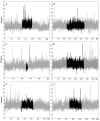Over half of breakpoints in gene pairs involved in cancer-specific recurrent translocations are mapped to human chromosomal fragile sites
- PMID: 19183484
- PMCID: PMC2642838
- DOI: 10.1186/1471-2164-10-59
Over half of breakpoints in gene pairs involved in cancer-specific recurrent translocations are mapped to human chromosomal fragile sites
Abstract
Background: Gene rearrangements such as chromosomal translocations have been shown to contribute to cancer development. Human chromosomal fragile sites are regions of the genome especially prone to breakage, and have been implicated in various chromosome abnormalities found in cancer. However, there has been no comprehensive and quantitative examination of the location of fragile sites in relation to all chromosomal aberrations.
Results: Using up-to-date databases containing all cancer-specific recurrent translocations, we have examined 444 unique pairs of genes involved in these translocations to determine the correlation of translocation breakpoints and fragile sites in the gene pairs. We found that over half (52%) of translocation breakpoints in at least one gene of these gene pairs are mapped to fragile sites. Among these, we examined the DNA sequences within and flanking three randomly selected pairs of translocation-prone genes, and found that they exhibit characteristic features of fragile DNA, with frequent AT-rich flexibility islands and the potential of forming highly stable secondary structures.
Conclusion: Our study is the first to examine gene pairs involved in all recurrent chromosomal translocations observed in tumor cells, and to correlate the location of more than half of breakpoints to positions of known fragile sites. These results provide strong evidence to support a causative role for fragile sites in the generation of cancer-specific chromosomal rearrangements.
Figures


References
Publication types
MeSH terms
Substances
Grants and funding
LinkOut - more resources
Full Text Sources

